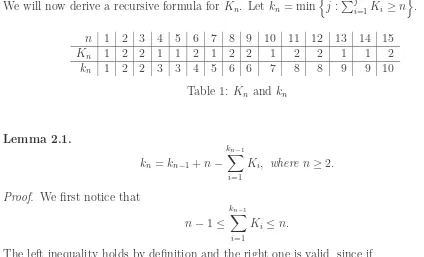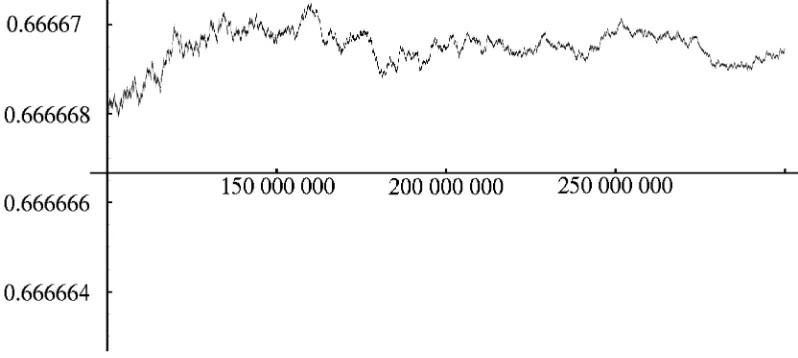23 11
Article 06.3.7
Journal of Integer Sequences, Vol. 9 (2006), 2
3 6 1 47
A Recursive Formula for the
Kolakoski Sequence
A000002
Bertran Steinsky
F¨
urbergstrasse 56
5020 Salzburg
Austria
[email protected]
Abstract
We present a recursive formula for the nth term of the Kolakoski sequence. Using
this formula, it is easy to find recursions for the number of ones in the first n terms
and for the sum of the firstnterms of the Kolakoski sequence.
1
Introduction
The Kolakoski sequence Kn [6, 7], which we study here, is the unique sequence starting
with 1 which is identical to its own runlength sequence. Kn is Sloane’s sequence A000002.
Kimberling asks 5 questions about this sequence on his homepage [5]. The first one is, whether there exists a formula for the nth term of the Kolakoski sequence. For a survey of known properties of the Kolakoski sequence we refer to Dekking [4]. Cloitre wrote the formulas
KN =
3 + (−1)n
2 and KN+1 =
3−(−1)n
2 , where N =
n
X
i=1
Ki,
in the entry of Sloane’s sequenceA000002, where we also find block-substitution rules, which where posted by Lagarias. I.e., starting with 22 we have to apply 22 → 2211, 21 → 221, 12 → 211, and 11 → 21, as it was mentioned by Dekking [3, 4]. Culik et al. [2] proposed the double substitution rules σ1(1→ 1,2 →11) and σ2(1 →2,2 → 22), which are applied
alternatingly to each letter of a word. These substitutions can also be found at Allouche et al. [1, p. 336]. Cloitre added the relationship
f1(n) +f2(n) = 1 +
n−1
X
i=0
to Sloane’s sequence A054349, where f1(n) denotes the number of ones and f2(n) denotes
the number of twos in the nth string of Sloane’s sequence A054349.
2
A Recursive Formula for the Kolakoski Sequence
We will now derive a recursive formula for Kn. Let kn = min
n
j :Pj
i=1Ki ≥n
o
.
n 1 2 3 4 5 6 7 8 9 10 11 12 13 14 15
Kn 1 2 2 1 1 2 1 2 2 1 2 2 1 1 2
kn 1 2 2 3 3 4 5 6 6 7 8 8 9 9 10
Table 1: Kn and kn
Lemma 2.1.
kn=kn−1+n−
kn−1
X
i=1
Ki, where n≥2.
Proof. We first notice that
n−1≤
kn−1
X
i=1
Ki ≤n.
The left inequality holds by definition and the right one is valid, since if
kn−1
X
i=1
Ki ≥n+ 1
we would have
kn−1−1
X
i=1
Ki ≥n−1
which is a contradiction to the minimality of kn−1. So, as the first case, we consider
Pkn−1
i=1 Ki = n −1 which implies kn = kn−1 + 1 = kn−1 +n −
Pkn−1
i=1 Ki. In the second
case Pkn−1
i=1 Ki =n leads tokn=kn−1 =kn−1+n−
Pkn−1
i=1 Ki.
We notice that Lemma 2.1 holds in general for every sequence, whose only values are 1 and 2.
Lemma 2.2.
kn=kn−1+|Kn−Kn−1|= 1 +
n
X
i=2
Proof. The following well known construction produces a sequence which is identical to
K. Start with K1 ones, continue with K2 twos, followed by K3 ones, and so on. In this
construction, afterkn−1 steps two cases can appear, as described in the proof of Lemma2.1.
The first possibility is thatPkn−1
i=1 Ki =n−1, which means that we have constructed n−1
terms of the sequence. Therefore, by construction,Kn must be different fromKn−1 implying
kn − kn−1 = |Kn − Kn−1|. In the second case that
Corollary 2.1 is an implication of Lemma2.2.
Corollary 2.1.
Kn≡kn (mod 2) or Kn =
(−1)kn + 1
2 + 1 respectively. Corollary 2.2 uses Lemma 2.1 and Corollary 2.1.
Corollary 2.2.
Corollary 2.3 follows from Corollary 2.2.
Corollary 2.3.
Proof. From Lemma 2.1 and Lemma 2.2 we obtain
|Kn−Kn−1|=n−
and use the fact that
|Kn−Kn−1|=
Kn−Kn−1
3−2Kn−1
3
Concluding Remarks
Let sn =
Pn
i=1Ki, which is Sloane’s sequence A054353, on = |{1≤j ≤n:Kj = 1}|, and
tn = |{1≤j ≤n :Kj = 2}|, which is Sloane’s sequence A074286. With Theorem 2.1 and
the equations
Kn = sn−sn−1,
Kn = −on+on−1+ 2, and
Kn = tn−tn−1+ 1
it is easy to produce recursive formulas forsn, on, and tn.
By Lemma 2.1, we obtain kn = n − tkn−1, from which it follows that tn/n converges if and only if the limit of kn/n exists. The definition of kn gives the equations ksn = n
and ksn+1 =n+ 1, which yield that the limit of kn/n exists, if and only if sn/n converges.
Therefore, if we assume that one of the sequencestn/n,on/n,kn/norsn/nconverges then all
sequences have a limit. Ifa= limn→∞tn/nthen limn→∞on/n= 1−a, limn→∞sn/n= 1 +a,
and limn→∞kn/n= 1/(1 +a).
Using the recursion of Corollary2.3, we computedkn/nup ton = 3·108. Figure1shows
kn/n forn from 108 to 3·108, where only each 1000th point is drawn, i.e., the subsequence
k1000n/(1000n), forn = 100000, . . . ,300000. The x-axis is positioned at 2/3.
Figure 1: kn
n for n from 10
8
to 3·108
.
If we assume that the limit of on/n exists and is equal to 1/2 then kn/n must tend to
2/3. Thus, the graph in Figure 1 does not support the conjecture that on/n converges to
1/2.
4
Acknowledgement
References
[1] J.-P. Allouche, J. Shallit, Automatic Sequences, Cambridge Univ. Press, Cambridge, 2003.
[2] K. Culik, J. Karhum¨aki, Iterative devices generating infinite words,Lec. Notes in Comp. Sc. 577 (1992), 531–544.
[3] F. M. Dekking, Regularity and irregularity of sequences generated by automata, S´em. Th. Nombres Bordeaux ‘79-‘80 (1980), 901–910.
[4] F. M. Dekking, What is the long range order in the Kolakoski sequence?, The Mathe-matics of Long-Range Aperiodic Order, NATO Adv. Sci. Inst. Ser. C Math. Phys. Sci.
489, Kluwer Acad. Publ., Dordrecht (1997), 115–125.
[5] C. Kimberling, http://faculty.evansville.edu/ck6/integer/index.html
[6] W. Kolakoski, Problem 5304: Self Generating Runs, Amer. Math. Monthly 72 (1965), 674.
[7] W. Kolakoski, Problem 5304,Amer. Math. Monthly 73 (1966), 681–682.
2000 Mathematics Subject Classification: Primary 11B83; Secondary 11B85, 11Y55, 40A05. Keywords: Kolakoski sequence, recursion, recursive formula.
(Concerned with sequences A000002, A054349,A054353, and A074286.)
Received January 13 2006; revised version received August 19 2006. Published inJournal of Integer Sequences, August 19 2006.

